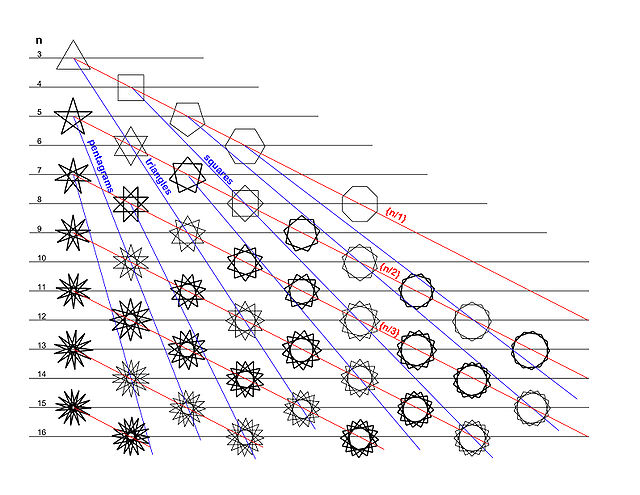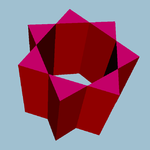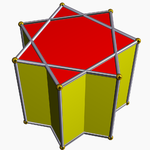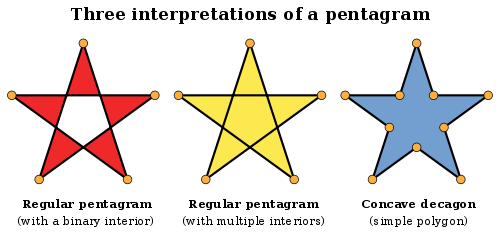- Star polygon
-
Set of regular star polygons 
{5/2}
{7/2}
{7/3}
{8/3}
{9/2}
{9/4}
{10/3}... Schläfli symbol
2<2q<p
gcd(p,q)=1{p/q} Vertices and Edges p Coxeter–Dynkin diagram 




Symmetry group Dihedral (Dp) Dual polygon Self-dual Internal angle
(degrees) [1]
[1]A star polygon is a non-convex polygon which looks in some way like a star. Only the regular ones have been studied in any depth; star polygons in general appear not to have been formally defined. They should not be confused with star domains.
Contents
Regular star polygons
In geometry, a regular star polygon is a self-intersecting, equilateral equiangular polygon, created by connecting one vertex of a simple, regular, p-sided polygon to another, non-adjacent vertex and continuing the process until the original vertex is reached again.[2] Alternatively for integers p and q, it can be considered as being constructed by connecting every qth point out of p points regularly spaced in a circular placement.[3] For instance, in a regular pentagon, a five-pointed star can be obtained by drawing a line from the first to the third vertex, from the third vertex to the fifth vertex, from the fifth vertex to the second vertex, from the second vertex to the fourth vertex, and from the fourth vertex to the first vertex. The notation for such a polygon is {p/q} (see Schläfli symbol), which is equal to {p/p-q}. Regular star polygons will be produced when p and q are relatively prime (they share no factors). A regular star polygon can also be represented as a sequence of stellations of a convex regular core polygon. Regular star polygons were first studied systematically by Thomas Bradwardine.
Examples

Star figures
If the number of sides n is evenly divisible by m, the star polygon obtained will be a regular polygon with n/m sides. A new figure is obtained by rotating these regular n/m-gons one vertex to the left on the original polygon until the number of vertices rotated equals n/m minus one, and combining these figures. An extreme case of this is where n/m is 2, producing a figure consisting of n/2 straight line segments; this is called a degenerate star polygon.
In other cases where n and m have a common factor, a star polygon for a lower n is obtained, and rotated versions can be combined. These figures are called star figures or improper star polygons or compound polygons. The same notation {n/m} is often used for them, although authorities such as Grünbaum (1994) regard (with some justification) the form k{n} as being more correct, where usually k=m.
A further complication comes when we compound two or more star polygons, as for example two pentagrams, differing by a rotation of 36°, inscribed in a decagon. This is correctly written in the form k{n/m}, as 2{5/2}, rather than the commonly-used {10/4}.
A six-pointed star, like a hexagon, can be created using a compass and a straight edge:
- Make a circle of any size with the compass.
- Without changing the radius of the compass, set its pivot on the circle's circumference, and find one of the two points where a new circle would intersect the first circle.
- With the pivot on the last point found, similarly find a third point on the circumference, and repeat until six such points have been marked.
- With a straight edge, join alternate points on the circumference to form two overlapping equilateral triangles.
Symmetry
Regular star polygons and star figures can be thought of as diagramming cosets of the subgroups
 of the finite group
of the finite group  .
.The symmetry group of {n/k} is dihedral group Dn of order 2n, independent of k.
Irregular star polygons
 The white line in this graph is an irregular hexagonal cyclic polygon, defining the a vertex figure for the great retrosnub icosidodecahedron. The edge lengths are defined by the distance between alternate vertices in the faces of the uniform polyhedron.
The white line in this graph is an irregular hexagonal cyclic polygon, defining the a vertex figure for the great retrosnub icosidodecahedron. The edge lengths are defined by the distance between alternate vertices in the faces of the uniform polyhedron.
A star polygon need not be regular. Irregular cyclic star polygons occur as vertex figures for the uniform polyhedra, defined by the sequence of regular polygon faces around each vertex, allowing for both multiple turns, and retrograde directions. (See vertex figures at List of uniform polyhedra) [4]
The unicursal hexagram is another example of a cyclic irregular star polygon, containing only D2h Dihedral symmetry.
Interiors of star polygons
Star polygons leave an ambiguity of interpretation for interiors. This diagram demonstrates three interpretations of a pentagram.
- The left-hand interpretation has the 5 vertices of a regular pentagon connected alternately on a cyclic path, skipping alternate vertices. The interior is everything immediately left (or right) from each edge (until the next intersection). This makes the core convex pentagonal region actually "outside", and in general you can determine inside by a binary even-odd rule of counting how many edges are intersected from a point along a ray to infinity.
- The middle interpretation also has the 5 vertices of a regular pentagon connected alternately on a cyclic path. The interior may be treated either:
- as the inside of a simple 10-sided polygon perimeter boundary, as below.
- with the central convex pentagonal region surrounded twice, because the starry perimeter winds round it twice.
- The right-hand interpretation creates new vertices at the intersections of the edges (5 in this case) and defines a new concave decagon (10-pointed polygon) formed by perimeter path of the middle interpretation; it is in fact no longer a pentagram.
What is the area inside the pentagram? Each interpretation leads to a different answer.
Example interpretations of a star prism

Heptagrams with
2-sided interior
Heptagrams with
a simple perimeter interiorThe heptagrammic prism above shows different interpretations can create very different appearances.
Builders of polyhedron models, like Magnus Wenninger, usually represent star polygon faces in the concave form, without internal edges shown.
Star polygons in art and culture
Star polygons feature prominently in art and culture. Such polygons are may or may not be regular but they are always highly symmetrical. Examples include:
- The {5/2} star pentagon is also known as a pentagram, pentalpha or pentangle, and historically has been considered by many magical and religious cults to have occult significance.
- The simplest non-degenerate complex star polygon which is two {6/2} polygons (i.e., triangles), the hexagram (Star of David, Seal of Solomon).
- The {7/3} and {7/2} star polygons which are known as heptagrams and also have occult significance, particularly in the Kabbalah and in Wicca.
- The complex {8/2} star polygon (i.e. two squares), which is known as the Star of Lakshmi and figures in Hinduism;
- The {8/3} star polygon (octagram), and the complex star polygon of two {16/6} polygons, which are frequent geometrical motifs in Mughal Islamic art and architecture; the first is on the coat of arms of Azerbaijan.
- An eleven pointed star called the hendecagram, which apparently was used on the tomb of Shah Nemat Ollah Vali.
Some symbols based on a star polygon have interlacing, by small gaps, and/or, in the case of a star figure, using different colors.
See also
- Complex polygon
- List of regular polytopes - Nonconvex forms (2D)
- Magic star
- Star polyhedron
- Star polychoron (4-polytopes)
- Star-shaped polygon
- Stellation#Stellated polygons
References
- ^ Kappraff, Jay (2002). Beyond measure: a guided tour through nature, myth, and number. World Scientific. pp. 258. ISBN 9789810247027. http://books.google.com/books?id=vAfBrK678_kC&pg=PA256&dq=star+polygon.
- ^ Coxeter, Harold Scott Macdonald (1973). Regular polytopes. Courier Dover Publications. ISBN 9780486614809.
- ^ Weisstein, Eric W., "Star Polygon" from MathWorld.
- ^ H. S. M. Coxeter, M. S. Longuet-Higgins, J. C. P. Miller, Uniform polyhedra, Phil. Trans. 1954 (Tables 6-8)
- Cromwell, P.; Polyhedra, CUP, Hbk. 1997, ISBN 0-521-66432-2. Pbk. (1999), ISBN 0-521-66405-5.
- Grünbaum, B. and G. C. Shephard; Tilings and Patterns, New York: W. H. Freeman & Co., (1987), ISBN 0-7167-1193-1.
- Grünbaum, B.; Polyhedra with Hollow Faces, Proc of NATO-ASI Conference on Polytopes ... etc. (Toronto 1993), ed T. Bisztriczky et al., Kluwer Academic (1994) pp. 43–70.
- John H. Conway, Heidi Burgiel, Chaim Goodman-Strass, The Symmetries of Things 2008, ISBN 978-1-56881-220-5 (Chapter 26. pp. 404: Regular star-polytopes Dimension 2)
External links
Regular polygons Listed by number of sides1–10 sides 11–20 sides Others Star polygons Categories:- Polygons
Wikimedia Foundation. 2010.





